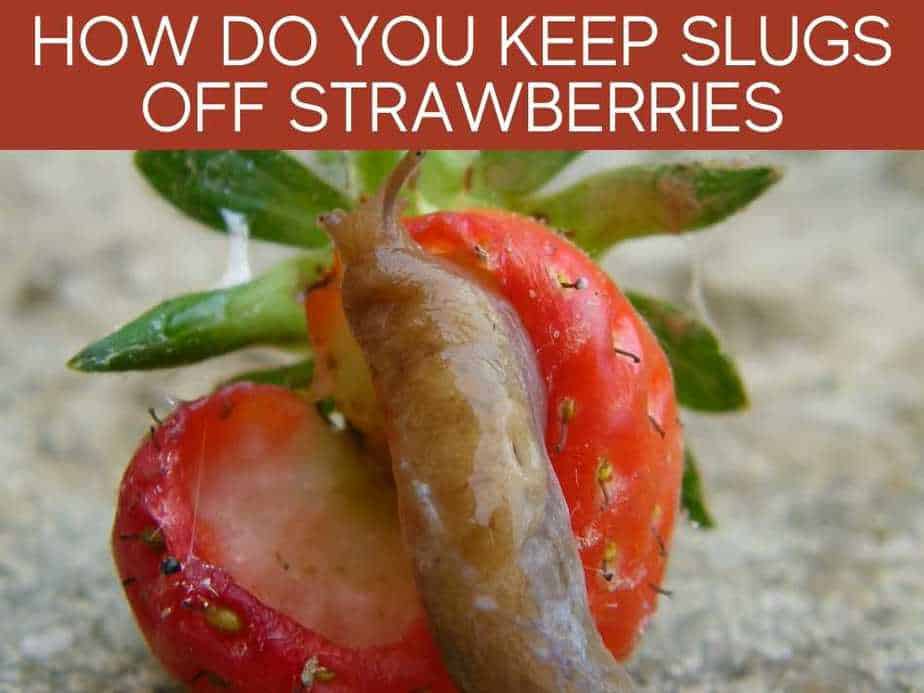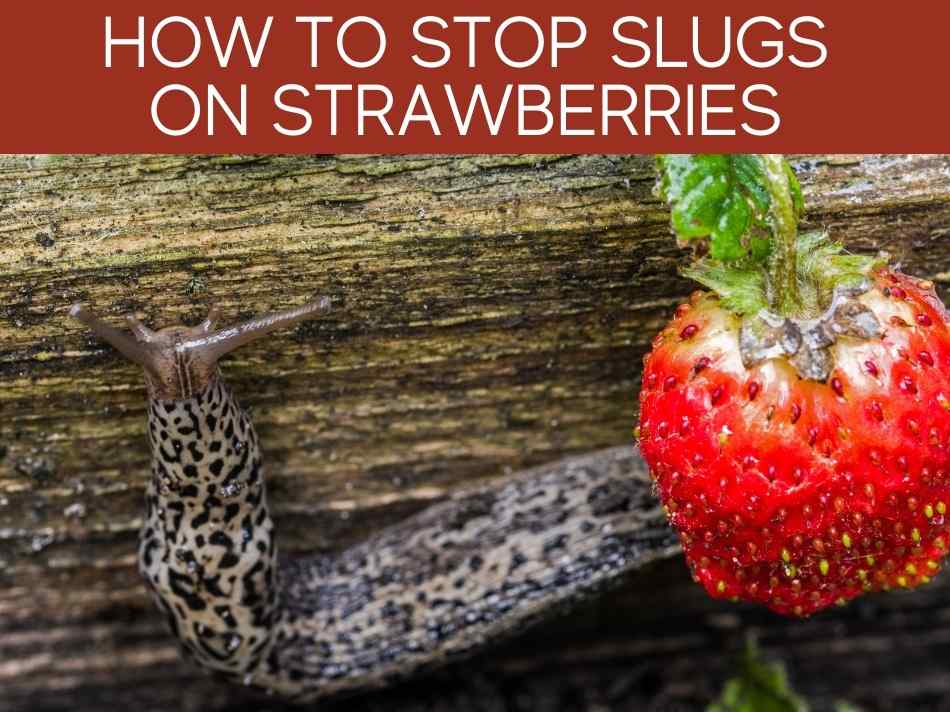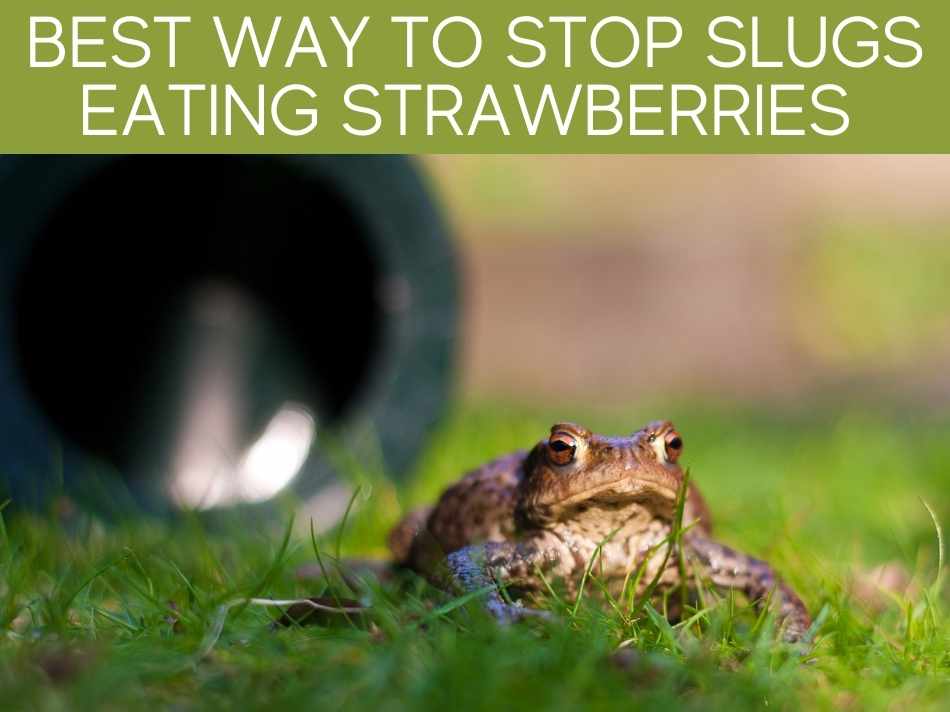Have you been wondering how to keep slugs from strawberries lately? It can be heartbreaking to find out that the strawberries you’ve been waiting to pick for so long have been savaged by slugs! Thankfully, there are certain measures you can take to save your crop from further damage.
Make the area less hospitable to the slugs by preventing wet conditions, eliminating their hideouts, encouraging predators in the garden and using slug repellents. Other ways to control slug population include deploying slug traps, using diatomaceous earth and organic slug killers.
To put up a successful fight against slugs, it’s worth learning how to use these techniques, either singly or in combination. Often, slug management includes trying out several techniques before you can enjoy slug-free strawberries from your garden.
How To Keep Slugs From Strawberries

Slugs love eating ripe strawberries.
Just when you start thinking the harvest time is approaching, slugs turn up to shatter your dreams of those perfect garden-fresh strawberries.
They eat away the ripe fruit, leaving holes in the strawberry.
These holes render the fruit inedible and also attract other pests, including beetles and weevils to your strawberry patch.
There are many techniques you can use to keep slugs from strawberries.
Planting slug-resistant plants around the strawberries is an effective organic approach.
Agapanthus, bamboo, hens and chickens, sedum, sweet woodruff are some of the plants you can grow to keep slugs away.
Another approach is to tweak your irrigation schedule.
Avoid watering strawberries in the evening because that’s when slugs will feed and they love wet conditions.
Some simple adjustments to the garden can help keep slugs away from your strawberries naturally.
You don’t have to resort to chemical means unless it’s absolutely necessary.
The last thing you would want is to ingest any chemical-laden strawberries that could harm your health.
Chemical control also harms beneficial insects, birds, worms and other wildlife in your garden.
Check out our complete article for how to keep slugs out of your garden.
How Do You Keep Slugs Off Strawberries

Are slugs attacking your beautiful strawberries?
Before practicing techniques to keep slugs off strawberries, it’s worth making sure that it’s slugs that are bothering the plants.
If you confuse their damage with some other pest that’s actually the culprit and use the wrong technique, all the efforts will go to waste while the critters continue eating away your harvest.
So the first thing you’ll need to do is to diagnose the problem.
Inspect the garden at night because that’s when slugs are most active and easy to spot.
Once you’re sure that it’s slugs that you’re up against, there are some effective techniques to keep slugs off strawberries.
Creating barriers around the strawberry plants can help keep off slugs.
Many gardeners install a barrier of copper strip around the strawberry plants to keep the slugs out.
Tests have shown that slugs can experience an electric shock if their body comes in contact with copper.
When purchasing copper strips from the garden center, make sure they are wide enough that slugs can’t cross over it by raising their bodies.
If you’re growing strawberries in raised beds, you can simply staple copper tape around the boundaries to keep slugs off.
Other barriers include diatomaceous earth and wood ashes.
Both the materials repel slugs in dry form.
Sprinkle them around the plants to create a boundary that slugs won’t cross.
These repellants irritate the skin of slugs when they come in contact with them, thus preventing them from crossing the barrier.
How To Keep Slugs Off Strawberry Plants Organically

One of the challenges of organic growers is to decide on which techniques to employ that will get rid of the pests but will keep the garden and their harvests organic.
If you’re looking for organic management for slugs in your strawberry garden, you won’t be disappointed.
With the sudden boost in the number of organic farms to attract health conscious people, many techniques have been developed to manage pests organically.
Slug traps are available at most garden centers and are effective in keeping slugs off organically.
Leave these traps in place for a day before turning them over and collecting and discarding the slugs.
You can also make homemade traps by placing inverted watermelon rinds, cabbage leaves or flower pots around the plants.
Slugs will feed during the night and hide under these traps during day time.
Check these traps and destroy the pests every morning until their population drops.
The buggers you find also make a good addition to your compost heap.
Many iron-phosphate based slug baits are also approved for organic farmers.
These commercial, organic baits are toxic to slugs and snails but are certified safe for humans, pets and pollinators so you may use these besides other organic practices.
Check out the complete article on how to get rid of slugs naturally.
Another organic method some gardeners use for controlling slugs is coffee grounds.
Check out the full article on using coffee grounds in the garden.
How To Get Rid Of Slugs On Strawberry Plants

So you’ve spotted snails around your strawberry patch.
Even if you haven’t spotted these limit creators, their damage easily gives them away.
Round holes in leaves and fruits, decapitated seedlings, traces of silvery slime on the leaves and ground are all indications that slugs have been sneaking around the strawberry plants.
So once you know for sure that slugs are eating away your strawberries, what can you do to get rid of them?
One of the most popular techniques used by gardeners to get rid of slugs on strawberry plants is to install beer traps in the area.
Bury a few yogurt or margarine containers into the soil around the strawberry plants such that the rim is at soil level and fill them with beer.
Slugs are attracted to the fermentation taking place in the container.
They will visit the container every night and drown in the mixture.
You’ll need to discard the contents of the container and fill them up again every time they’re filled with slugs.
Instead of beer, you can also use a water, sugar and yeast mixture since it will also ferment and create the same effect.
Another straightforward approach is to go out on patrol every night, hunting for slugs and destroying any you may find.
Pick the slugs off the strawberry plants and drop them in soapy water to destroy them.
Of course, this is a labor-intensive technique and not always feasible, especially if the slug population is high.
Be sure to check out the fill article on using beer in the garden.
How To Stop Slugs On Strawberries

Slugs love your strawberries just as much as you do. They’ll eat away the ripe fruits quickly, leaving behind mutilated, unsightly fruits for you.
Unless you take serious measures to stop the attackers, you won’t be able to keep any of those lovely strawberries for yourself.
Other than the homemade beer trap discussed earlier in the post, different varieties of slug baits are available commercially too.
Some of these products are approved for organic farmers, while there are non-organic options too.
Several varieties of iron-phosphate based slug baits, including Sluggo and Escar-Go, are approved for organic growing.
Iron-phosphate works by disrupting the calcium metabolism in the slug’s digestive system, causing them to stop feeding and die within a week.
Alternatively, Metaldehyde-based slug baits, including Deadline, are also used conventionally by farmers, though they are not organic and should be avoided on edible crops.
Metaldehyde works by dehydrating the bodies of slugs and snails. However, if there’s a forecast for rain soon after the application, or there’s water in the vicinity, the product will have reduced efficacy.
These baits will need to be reapplied weekly and after every rain for it to be effective.
How To Keep Slugs Out Of Strawberry Patch

Your strawberry patch will need some additional care if you fear there are slugs around the area.
Look for ways to make the patch less welcoming to slugs and keep them out.

Slugs love moisture and shelter and if we can take that away, it might just be possible to overpower them.
Slugs love wet conditions, so that’s what you should aim at avoiding.
Prevent overly wet soil and water less frequently to discourage the slugs from visiting the patch.
Get rid of any loose mulch around the plants where the slugs might hide.
Avoid using straw and hay mulch, and instead, replace it with compost or leaf mold if you want to mulch the plants.
Though you should water less frequently, every time you water, water deeply so the moisture requirements of your strawberry plants are addressed.
Best Way To Stop Slugs Eating Strawberries

It’s natural to want to stop slugs from eating those beautiful strawberries.
After all, you’ve spent all season watering them, feeding them and taking care of them, just to enjoy the delicious fruit that they’ll give at the end of the season.
You wouldn’t want slugs from eating away the bigger share of your harvest.
One of the most effective techniques to stop slugs is to introduce predators in the garden.

Toads, lizards, snakes, birds, beetles, newts, ducks, salamanders, porcupines, millipedes and racoons will quickly eat away the slugs and eliminate them from your strawberry patch.
Encourage the predators that most suit your gardening layout and the slug population will die down.
Nematodes are also often applied to the soil to stop slugs.
Once slugs feed on nematodes, they will act as a parasite inside them, swelling up the body from within, stopping them from feeding within just a few days and killing them within a week.
Other strawberry pests
In addition to slugs, there are other pests that eat strawberry plants. The largest of these are birds. The smallest are bugs, such as weevils and spittle bugs. You can protect your strawberry plants from birds by covering them with bird netting. You can cover the plants with row covers to discourage the bugs from laying eggs on the leaves.
Can birds eat strawberries?
Birds are one of the main pests that attack strawberry plants. They are attracted to the fruit and don’t eat the leaves and stems. The berries contain nutrients.
Birds can eat strawberries, which contain some nutrients they need.
They only eat the fruit, not the leaves or stems.
The birds do have to get at the individual strawberry plants.
Mostly, birds perch on the strawberry plants and eat the fruit.
Others pick the berries and take them elsewhere to eat.
How to protect strawberries from birds
Strawberries can be protected from birds by distracting their attention with fake predators or shiny objects. The more effective way of keeping the birds away is by erecting barriers in the form of nets.
One way to protect strawberries from birds is to distract them or disturb them.
This should prevent them from staying in the patch long enough to do any damage.
Good ways to disturb the birds is to put scarecrows in the fields.
You can also plant plastic snakes, or even hang shiny objects, like CDs.
However, birds quickly learn to recognise if things don’t move around in a field.
This means you’ll have to spend time regularly moving scarecrows and false snakes around.
In the long run, the distracting approach isn’t particularly successful.
The best way to protect strawberries from birds is to stop them from getting to the plants at all.
This means covering them with bird netting.
You’ll need some sort of support structure to hold it up.
This can be a high structure of poles.
You can also protect individual plants, or a few plants, by using strawberry cages.
How to protect strawberries from pests
Strawberries can be protected from pests by covering them with netting or row covers. The netting will prevent the larger pests, like birds, from reaching the plants. The row covers will discourage adult insects from laying their eggs on the leaves.
You can protect your strawberry plants from larger pests by covering the plants in some kind of wire mesh or netting.
You can also grow your strawberries in cages.
These methods will prevent pests from reaching the plants.
It is not as simple to protect the strawberry plants from smaller, even tiny, pests.
One method is to make sure the strawberry plants are not sitting in an environment in which the bugs like to live.
Slugs hatch and live in rich, decaying organic matter.
You can prevent slugs from eating your strawberries by making sure there is no organic matter of this kind around the base of the plants.
The best way of protecting your strawberry plants from insects is to stop them getting onto the plants in the first place.
Preferably plant your strawberries in cages or planters that you can fill up with a soil mix that has been treated for bugs.
You can deter bugs from laying eggs on the fruit or leaves if you cover the strawberries with row covers.
Another precaution is to spray the plants with a spray that will make the leaves, stems and fruit taste horrible.
If the insects do get onto your strawberry plants, you can use neem oil to wash them off.
A great way to protect strawberries from pests is to grow strawberries hydroponically.
Strawberry cages
Strawberry cages are similar to a cover that is placed over the plants. They are made from wooden, plastic or even metal frames covered with wire or some form of netting. The cages cover the top and sides of the strawberries.
A strawberry cage is literally a cover you can place over your plants.
The frame is covered with chicken wire.
You can also cover the frame with bird netting, or shade cloth, if you want to keep smaller pests out.
A strawberry cage will not keep tiny pests away from the plants.
There are basically two types of strawberry cages.
You can make a frame that covers the plants from on top and around the sides.
Then there are the cages that are raised boxes, with a solid base on which the strawberries are grown.
These should also protect the plants from smaller pests that can grow in the soil.
Strawberry pests
Most strawberry pests are tiny bugs that infest the plants and eat at the leaves, stems or fruit. Slugs and snails can also eat the plants. The largest pests that go for strawberry plants are birds.
The largest strawberry pests are birds.
They differ from the other pests, because they come at the plants from above.
After they have flown down to the strawberries, the birds perch on the stems or leaves and eat the fruit.
Slugs are also common strawberry pests.
They are the opposite from birds, because they are small and attack the plants from the bottom.
The other pests that eat strawberry plants are insects.
Strawberry budweevils
Strawberry budweevils are tiny, dark bugs that can cause quite a lot of damage to the plants.
The adults are about 0,1 inch (2.4 mm) and differ from the root weevil.
These bugs cut the pedicels of buds and damage the growing fruit.
White groups of larvae can be found in the buds of the flowers on the strawberry plants.
Root weevils
Root weevils are only about 1/5th inch (0,5cm) and eat the young roots and crowns of the strawberry plants.
This damage results in stunted growth.
The adults can also eat the leaves, but this damage doesn’t affect the growth.
The root weevils feed at night.
Spittlebugs
Spittlebugs get their name from the patches of sticky bubbles that sit on the leaves of the strawberry plants.
This seems to be a foamy spit, but is actually the produce coming out of the anus of the young bugs.
Strawberry sap bugs
Strawberry sap bugs are found on damaged or over-ripe fruit.
They are oval, brown bugs of about one eighth to a quarter of an inch (3 – 6 mm) long.
These bugs eat the berries, leaving deep holes.
These can also cause more damage to the strawberry plants, because fungal spores can enter the fruit through the holes.
Why not go on to read all about how strawberries are a fruit?
Conclusion

There are a range of methods to keep slugs from eating away your strawberry harvest.
Choose one or a combination of techniques that suits your garden most and salvage what remains of your harvest.
Even if you can’t enjoy too many strawberries this season, now you know what needs to be done to keep the entire harvest to yourself next season.
